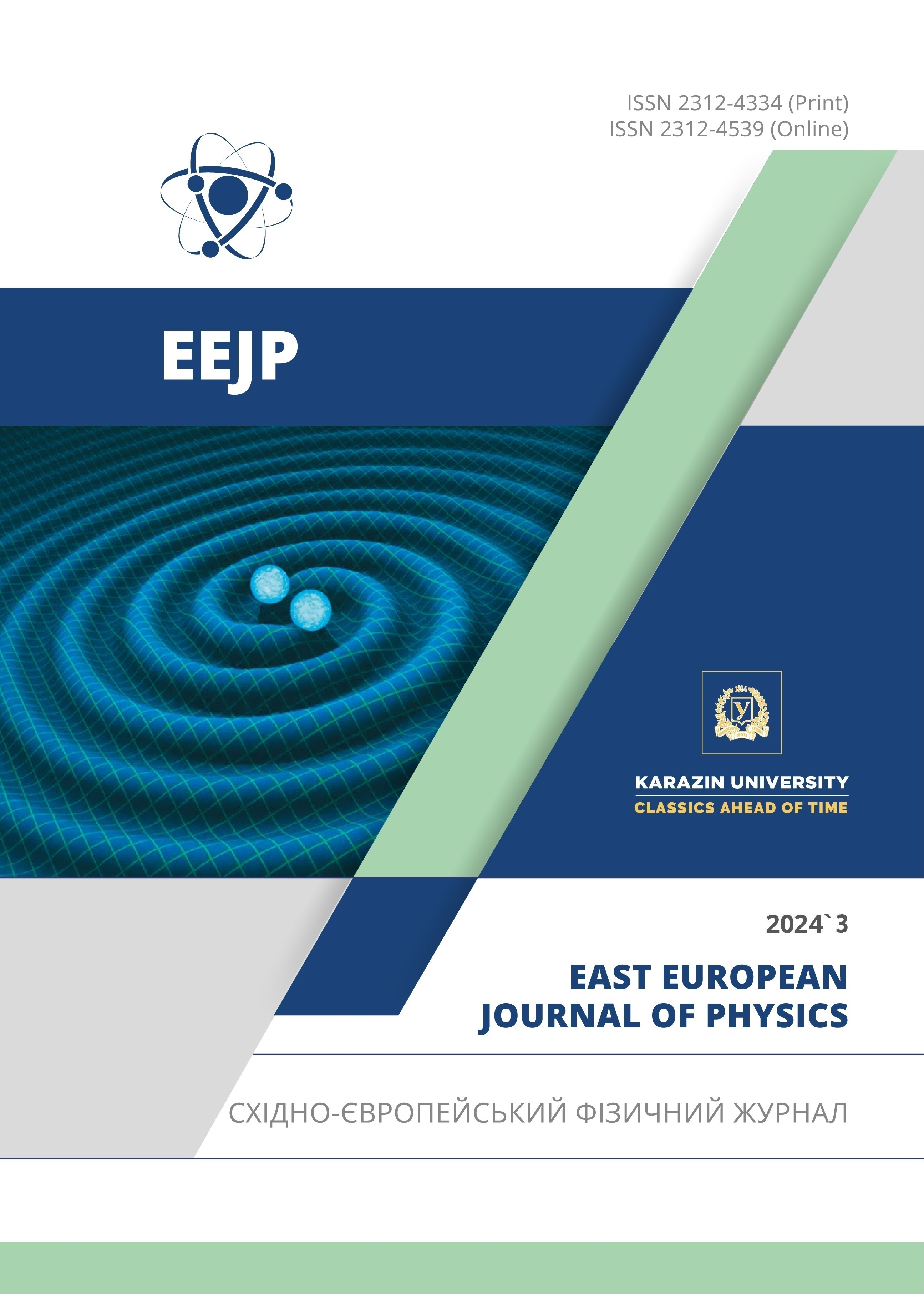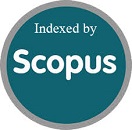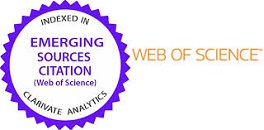Kaluza-Klein FRW Renyi Holographic Dark Energy model in Scalar-Tensor Theory of Gravitation
Abstract
This work examines the dark energy phenomenon by studying the Renyi Holographic Dark Energy (RHDE) and pressure-less Dark Matter (DM) within the frame-work of Saez-Ballester (SB) scalar-tensor theory of gravitation(Phys. Lett. A113, 467:1986). To achieve a solution, we consider the viable deceleration parameter (DP), which contributes to the average scale factor a=e(1/γ)[ √ (2γt+c1)], where γ, and c1 are respectively arbitrary, and integration constants. We have derived the field equations of SB scalar-tensor theory of gravity with the help of Kaluza-Klein FRW Universe. We have investigated cosmological parameters namely, DP (q), energy densities (ρM) and (ρR) of DM and RHDE, scalar field (ϕ), and equation of state parameter (ωR). The physical debate of these cosmological parameters are investigated through graphical presentation. Moreover, the stability of the model are studied through squared sound speed (vs2) and the well-known cosmological plane ωR - ω'R and all energy conditions and also, density parameters are analyzed through graphical representation for our model.
Downloads
References
A.G. Riess, et al.: Astron. J. 116, 1009 (1998). https://doi.org/10.1086/300499
S. Perlmutter, et al., Astrophys. J. 517, 565 (1999). https://doi.org/10.1086/307221
M. Padmanabhan, Phys. Rep. 380, 235 (2003). https://doi.org/10.1016/S0370-1573(03)00120-0
E.J. Copeland, M. Sami, and S.Tsujikawa, Int. J. Mod. Phys. D, 15, 1753 (2006). https://doi.org/10.1142/S021827180600942X
K. Bamba, et al., Astrophys. Space Sci. 342, 155 (2012). https://doi.org/10.1007/s10509-012-1181-8
P. Horava, and M. Djordje, Phys. Rev. Lett 85, 1610 (2000). https://doi.org/10.1103/PhysRevLett.85.1610
S. Thomas. Phys. Rev. Lett. 89, 081301 (2002). https://doi.org/10.1103/PhysRevLett.89.081301
S.D.H. Hsu, Phys. Lett. B, 594, 13 (2004). https://doi.org/10.1016/j.physletb.2004.05.020
M. Li, Phys. Lett. B, 603, 1 (2004). http://dx.doi.org/10.1016/j.physletb.2004.10.014
R. D’Agostino, Phys. Rev. D, 99, 103524 (2019). https://doi.org/10.1103/PhysRevD.99.103524
A. Majhi, Phys. Lett. B, 775, 32 (2017). https://doi.org/10.1016/j.physletb.2017.10.043
S. Abe, Phys. Rev. E, 63, 061105 (2001). https://doi.org/10.1103/PhysRevE.63.061105
T.S. Bir´o, and P. V´an, Phys. Rev. E, 83, 061147 (2011). https://doi.org/10.1103/PhysRevE.83.061147
M. Tavayef, A. Sheykhi, et al., Phys. Lett. B, 781, 195 (2018). https://doi.org/10.1016/j.physletb.2018.04.001
K.Y. Kim, H.W. Lee, and Y.S. Myung, Phys. Lett. B, 660, 118 (2008). https://doi.org/10.1016/j.physletb.2007.12.045
I.P. Neupane, Phys. Lett. B, 673, 111 (2009). https://doi.org/10.1016/j.physletb.2009.02.012
O.A. Lemets, D.A. Yerokhin, and L.G. Zazunov, J. Cosmol. Astropart. Phys. 01, 007 (2011). https://doi.org/10.1088/1475-7516/2011/01/007
H. Wei, and R.G. Cai, Phys. Lett. B, 665, 1 (2007). https://doi.org/10.1016/j.physletb.2007.08.066
A. Sheykhi, and M.R. Setare, Int. J. Theor. Phys. 49, 2777 (2010). https://doi.org/10.1007/s10773-010-0469-0
A. R´enyi, Prob. theory. (North-Holland, Amsterdam). 540-616 (1970).
H. Moradpour, A. Sheykhi, et al., Phys. Lett. B, 783, 82 (2018). https://doi.org/10.1016/j.physletb.2018.06.040
H. Moradpour, S. A. Moosavi, et al., Eur. Phys. J. C, 78, 829 (2018). https://doi.org/10.1140/epjc/s10052-018-6309-8
A. Jawad, K. Bamba, et al., Symmetry, 10, 635 (2018). https://doi.org/10.3390/sym10110635
A. Iqbal, and A. Jawad, Phys. Dark Univ. 26, 100349 (2019). https://doi.org/10.1016/j.dark.2019.100349
M. Younas, et al., Adv. High Energy Phys. 1287932, (2019). https://doi.org/10.1155/2019/1287932
A. Dixit, V.K. Bhardwaj, and A. Pradhan, (2020). https://doi.org/10.48550/arXiv.2010.10847
S. Chunlen, and P. Rangdeey, (2020). https://doi.org/10.48550/arXiv.2008.13730
U.K. Sharma and V.C. Dubey, (2020). https://doi.org/10.48550/arXiv.2001.02368
A. Sarfraz, S. Khan, and S. Sattar, (2020). https://arxiv.org/abs/2011.10046v1
U.K. Sharma, and V.C. Dubey, New Astronomy, 80, 101419 (2020). https://doi.org/10.1016/j.newast.2020.101419
A. Saha, et al., (2021). https://arxiv.org/abs/2101.04060v1
U.K. Sharma, and V.C. Dubey, Mod. Phys. Lett. A, 35(34), 2050281 (2021). https://doi.org/10.1142/S0217732320502818
U.Y.D. Prasanthi, and Y. Aditya, Results in Phys. 17, 103101 (2020). https://doi.org/10.1016/j.rinp.2020.103101
S. Bhattacharjee, Astrophys. and Space Sci. 365, 103 (2020). https://doi.org/10.1007/s10509-020-03820-7
M.V. Santhi, and Y. Sobhanbabu, Eur. Phys. J. C, 80, 1198, (2020). https://doi.org/10.1140/epjc/s10052-020-08743-9
Y. Sobhanbabu, and M.V. Santhi, Eur. Phys. J. C, 81, 1040 (2021). https://doi.org/10.1140/epjc/s10052-021-09815-0
U.Y.D. Prasanthi, and Y. Aditya, Phys. Dark Univ. 31, 100782 (2021). https://doi.org/10.1016/j.dark.2021.100782
Y. Sobhanbabu, and M.V. Santhi, Gen. Relativ. Gravit. 54, 95 (2022).
Y. Sobhanbabu, et al., New Astronomy, 104, 102066, (2023). https://doi.org/10.1016/j.newast.2023.102066
D. Saez, and V.J. Ballester, J. Phys. Lett. 113, 467 (1986). https://doi.org/10.1016/0375-9601(86)90121-0
R. Tiwari, R. Singh, and Shukla, Afric. Rev. Phys. B, 10, 0048 (2015). http://aphysrev.ictp.it/index.php/aphysrev/article/download/1137/460
U.K. Sharma, et al., Res. Astron. Astrophys. 19, 055 (2019). https://doi.org/10.1088/1674-4527/19/4/55
L.N. Granda, and A. Oliveros, Phys. Lett. B, 671, 199 (2009). https://doi.org/10.1016/j.physletb.2008.12.025
G. Hinshaw, et al., Astrophys. J. Suppl. 208, 19 (2013). https://doi.org/10.1088/0067-0049/208/2/19
S.W. Hawking, and G.F.R. Ellis, The Large-Scale Structure of Space Time, (Cambridge Unvi. Press, Cambridge, 1973).
R.M. Wald, Generality, (University of Chicago Press, Chicago) (1984).
M. Visser, Science, 276, 88 (1997). https://doi.org/10.1126/science.276.5309.88
C. Molina-Paris, and M. Visser, Phys. Lett. B, 455, 90 (2013). https://doi.org/10.1016/S0370-2693(99)00469-4
T. Singh, et al., Astro. Space Sci. 361, 106 (2016). https://doi.org/10.1007/s10509-016-2696-1
J. Santos, J.S. Alcaniz, et al., Phys. Rev. D, 76, 083513 (2007). https://doi.org/10.1103/PhysRevD.76.083513
E.-A. Kontou, and K. Sanders, (2020). https://arxiv.org/abs/2003.01815v2
U. Alam, et al. Mon. Not. R. Astron. Soc. 344, 1057 (2003). https://doi.org/10.1046/j.1365-8711.2003.06871.x
V. Sahni, et al., JETP Lett. 77, 201 (2003). https://doi.org/10.1134/1.1574831
M. Sharif, and A. Jawad, Eur. Phys. J. C, 73, 2600 (2013). https://doi.org/10.1140/epjc/s10052-013-2600-x
A. Al Mamon, et al., Universe, 7, 362 (2021). https://doi.org/10.3390/universe7100362
R.R. Caldwell, and E.V. Linder, Phys. Rev. Lett. 95, 141301 (2005). https://doi.org/10.1103/PhysRevLett.95.141301
R. Giostri, M. Vargas dos Santos, I. Waga, et al., J. Cosmol. Astropart. Phys. 3, 027 (2012). https://doi.org/10.1088/1475-7516/2012/03/027
N. Aghanim, et al., [Plancks Collaboration], (2018). https://arxiv.org/abs/1807.06209v2
Copyright (c) 2024 Y. Sobhanbabu, M. Vijaya Santhi, A. Srinivasa Rao, M. Praveen

This work is licensed under a Creative Commons Attribution 4.0 International License.
Authors who publish with this journal agree to the following terms:
- Authors retain copyright and grant the journal right of first publication with the work simultaneously licensed under a Creative Commons Attribution License that allows others to share the work with an acknowledgment of the work's authorship and initial publication in this journal.
- Authors are able to enter into separate, additional contractual arrangements for the non-exclusive distribution of the journal's published version of the work (e.g., post it to an institutional repository or publish it in a book), with an acknowledgment of its initial publication in this journal.
- Authors are permitted and encouraged to post their work online (e.g., in institutional repositories or on their website) prior to and during the submission process, as it can lead to productive exchanges, as well as earlier and greater citation of published work (See The Effect of Open Access).








